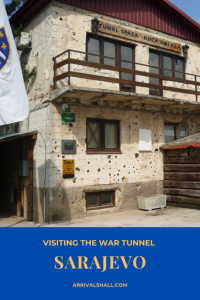When I joined the Amnesty International group in secondary school in the 1990s, scenes of the Balkan wars filled our news bulletins. A member of our AI group received a response from one of Milošević’s ministers.
I’ve always wondered if our letters had an impact. Twenty years later I found the answer to that question was a resounding no when visiting the Sarajevo War Tunnel, also known as the Tunnel of Hope.
This tour was one of the best things I did in Sarajevo. My Places to Visit in Sarajevo post has a list of other historically important sites in the city.
SNIPER ALLEY
Local tour company, Sarajevo Insider, runs an excellent Sarajevo Tunnel tour and comes recommended. Starting at their office near Latin Bridge, we travelled through the city by mini-bus in a westerly direction.
A few minutes into the tour we arrived at Sniper Alley, the name given to Ulica Zmaja od Bosne, and the place where Ratko Mladić’s henchmen murdered civilians from their sniper points in the surrounding hills during the city’s siege.
The most recognisable building on this street is the yellow Holiday Inn which housed journalists during the Siege of Sarajevo, a siege which lasted for 1,425 days between April 1992 and February 1996 – the longest for a capital city in modern history.
SARAJEVO TUNNEL MUSEUM
The airport soon came into sight. We meandered through a suburb until the bus arrived at a two-storey beige building, the outside of which was pock-marked by shells and bullets. This unremarkable building houses the Sarajevo Tunnel Museum and marks the westerly point of the tunnel which travels underneath the runway of Sarajevo airport.
Sarajevo is surrounded on three sides by hills which the Bosnian Serb army occupied during the Siege and used to blockade the city. The airport is located in the flat western side as the Tunnel Museum’s map of the city below illustrates.
A few weeks into the conflict the airport was included in the UN’s Safe Zone and was the only entry and exit point out of the living hell that Sarajevo had become. With snipers including the airport in their list of targets, crossing the airport runway became a game of roulette.
In 1993, the citizens of Sarajevo began building a tunnel underneath the runway. For the next three years food, medicines, electricity and other supplies were transported mainly by hand along this 800 metre-long tunnel, sustaining life in the blockaded Bosnian capital.
The Sarajevo Tunnel Museum has limited access into the actual tunnel but contains a comprehensive exhibition of life during the siege, an account of the tunnel construction, and a display of artillery used by the Bosnian Serb forces.
Most shocking of all was the display of UN food supplies where our guide showed an expiration date of 1970 on one of the packets.
SARAJEVO WAR TUNNEL DISCUSSION
One of the aims of the 1951 Treaty of Paris which created the European Coal and Steel Community (a precursor of the EU) was to prevent future wars in Europe by integrating its members.
Although Yugoslavia was not a member of the EEC/EU, its location next to three EEC/EU members has always prompted me to believe that the 1990s Balkan conflict should never have sunk to the bloody depths that it did. As an EU citizen, I feel great shame at the EU’s action/inaction over this.
However, throughout my visit to Sarajevo I learned that Bosnians don’t place blame with the EU but vehemently with the United Nations. I lost count of the number of times I heard sentences begin with the phrase “The inaction of the International Community” (i.e. UN) and end with the phrase “thanks to Bill Clinton and NATO” for it was the military offensive launched against Bosnian Serb army positions by the latter that eventually brought sides to sign the Dayton Peace Accords and thus end the Siege.
The group of eight which took the Sarajevo tunnel tour with me were very receptive to the guide’s presentation and comprised of four Germans, two Americans and one British person.
Such was the discussion the tour initiated I joined the Americans in the Hotel Europe where a chance meeting with Professor Ivo Komšić, the then Mayor of Sarajevo, brought the day’s politics round full circle.
The highlight of the tour was undoubtedly our guide whose first-hand experience of both constructing the tunnel and bringing supplies through it, from the free Bosnian territory to the people living in besieged Sarajevo, was eye-opening, awe-inspiring as well as profoundly courageous.
I left the Sarajevo War Tunnel tour asking serious questions of the UN and its inability to both manage and resolve the conflict. Sarajevo spent 1,425 days in hell losing over 11,000 of its citizens including 1,600 children. These statistics may only summarise Sarajevo’s suffering but they speak volumes about the international community.
Update: In 2016, Radovan Karadžić was found guilty of 10 of 11 charges at the International Criminal Court in The Hague and sentenced to 40 years in prison. In 2017, Ratko Mladic was found guilty of war crimes and genocide and sentenced to life imprisonment. Some of the charges both men were found guilty of related to the Siege of Sarajevo.
GETTING TO SARAJEVO
I travelled to Sarajevo by train from Mostar and travelled onwards from Sarajevo to Dubrovnik by bus. The GetByBus website has information on national and international routes to and from Sarajevo.
A number of other tourists I met flew directly into Sarajevo Airport from other European cities. My Visiting Bosnia post has further travel information.





